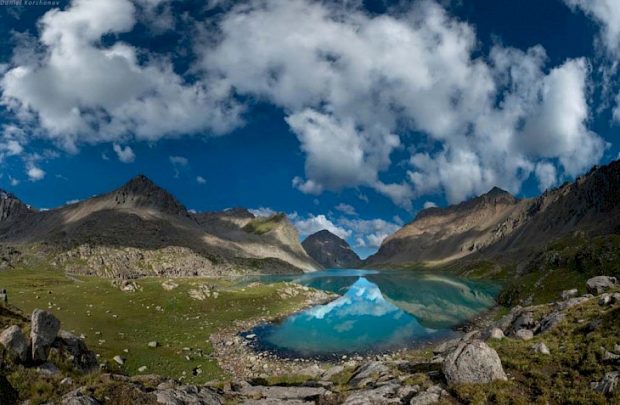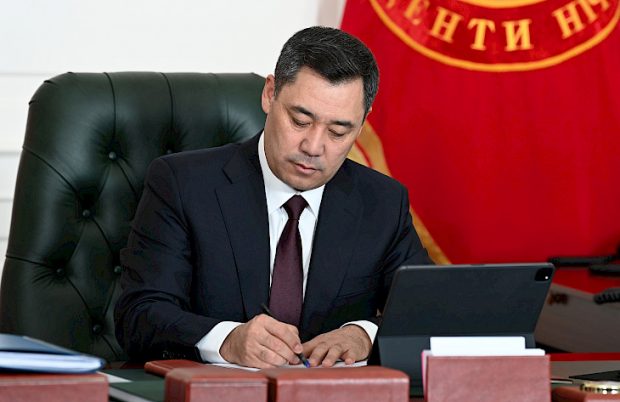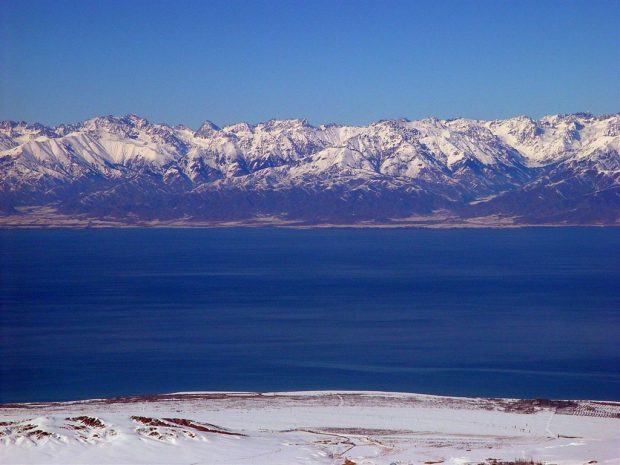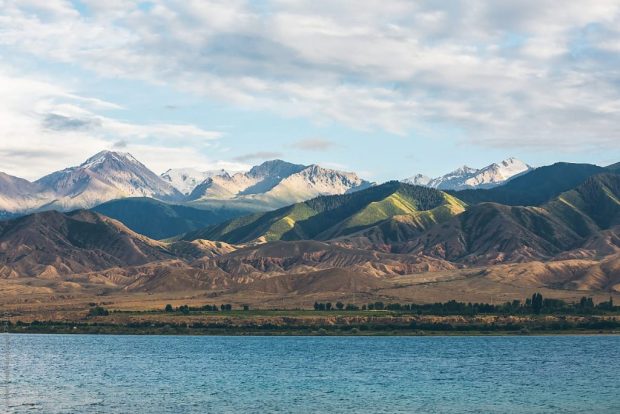Fighting climate change: Kyrgyzstan declares 2022 Year of Protection of Mountain Ecosystems and Climate Resilience

Kyrgyzstan is moving into action to protect its glaciers from the ominous onsluaghts of climate change by declaring 2022 the Year of Protection of Mountain Ecosystems and Climate Resilience (Photo: Kabar)
BISHKEK: Kyrgyzstan is taking the fight against climate change to much higher levels by declaring 2022 the Year of Protection of Mountain Ecosystems and Climate Resilience.
President of Kyrgyzstan Sadyr Zhaparov signed the declaration decree in order to increase climate resilience, preserve natural heritage and celebrate the International Year of Sustainable Mountain Development, Kabar News Agency reported citing the president’s press service.
On Dec. 16, 2021, the participants at the 76th session of the UN General Assembly unanimously adopted a resolution initiated by Kyrgyzstan declaring 2022 the International Year of Sustainable Mountain Development.
Under the decree, the Cabinet was directed to develop and approve the Roadmap for the Year of Protection of Mountain Ecosystems and Climate Resilience by March 1, 2022.
As part of the roadmap development, the issues of implementing environmental and climate measures and projects in agriculture, energy, industry, as well as projects for the development of forestry, ecotourism, emergency response, holding events at the international level, and organizing scientific and practical conferences are envisaged.
On Friday, Head of the Monitoring and Analysis of Reforms Department of the Presidential Administration Azamat Temirkulov, stressed the importance of glaciers, in particular those of Kyrgyzstan.
He noted that in the context of global climate change and global warming, the role and importance of mountainous countries increase all over the world as they are home to glaciers, from which water resources flow, which provides all vital functions not only for humans, but also for all living organisms in the world.
“Unfortunately, today the glaciers are melting, so the importance of glaciers, in particular the glaciers of Kyrgyzstan, is becoming significant not only for our country, but also for our neighbors and for the entire region and the world,” he said at a press conference at Kabar News Agency
“This is due to the fact that mountain glaciers are cooling points of our planet’s climate, which is why in order to preserve mountain ecosystems and glaciers, President Zhaparov proclaimed 2022 the Year of Mountain Ecosystems and Climate Stability.”
In 2017, Kyrgyzstan sounded the alarm by stressing that, according to forecasts, by 2025 the total area of glaciers in the country could decrease on average by 30-40%, which can lead to 25-35% reduction in water availability in Central Asia.
It warned at the United Nations that mountainous countries such as the Kyrgyz Republic were the first on the list of risks due to their complex mountain ecosystems.
“Climate change issues have an impact on all sectors of the Kyrgyz economy and cause significant damage in the form of increased natural disasters in mountainous areas – mudflows, landslides, floods and avalanches. Intensive melting of Kyrgyz glaciers, which are natural repositories, a zone of fresh water not only in Central Asia, but throughout the world, is of particular concern.”
According to UNICEF’s climate change expert Nicholas Molyneux quoted by Kabar in 2017, “climate change has a direct impact on the distribution of water resources. In Kyrgyzstan, for 20 years, the average temperature increased from 4.8°C to 6°C.”
“According to the most pessimistic forecasts for this century the average temperature in Kyrgyzstan may rise to 8°C from today’s average temperature. Because of its geographical location, Kyrgyzstan is one of the most vulnerable countries to climate change in Central Asia,” he said.

President Zhaparov signing the declaration decree (Kabar)
Addressing the World Journalist Conference on April 20, 2021, Kabar News Agency Director General Kuban Taabaldiev warned that dust storms rising from the bottom of the dried-up Aral Sea affect countries with large reserves of glaciers, such as Tajikistan and Kyrgyzstan, “because dust falling on the glaciers from the Aral Sea accelerates the melting of the ice.”
“The mountains of these countries accumulate almost 90% of the region’s glaciers, which have remained unchanged for centuries,” Taabaldiev said.
“The water reserves in the two countries are accumulated by glaciers melting in summer formed all account regional reserves. In other words, the glaciers of these two countries constitute the main source of drinking and irrigation water. The water flows of the Amu Darya River originate in the mountains of Tajikistan and run through the territory of four neighboring countries, the Naryn River, formed in the mountains of Kyrgyzstan, becomes the Syr Darya River. About 40 years ago, these rivers flowed into Lake Aral and kept its level in balance. Due to the melting of glaciers, the total area of glaciers in the two countries has decreased by 30%.”
Because of this, the inflow of water from the mountains into the main rivers of the two countries, the Amu Darya and the Syr Darya has significantly decreased, he added.

Kabar News Agency Director General Kuban Taabaldiev
“The decrease in water inflow in the summer is a matter of concern for the authorities of the two countries – if 15-20 years ago Kyrgyzstan and Tajikistan were considered as exporting countries of electricity, now, due to a lack of water in the winter, both Kyrgyzstan and Tajikistan are forced to buy electricity from their neighbors. This is only one of many consequences of climate change in the region,” he said in his presentation.

Issyk-Kul Lake in Winter (Photo: funart.pro)
Taabaldiev referred to Lake Issyk-Kul, famous in Central Asia as an increasingly attractive destination for tourists.
This lake is surrounded by high mountains, up to 5000 meters high. The peaks of these mountains have always remained covered with ice, even in the hottest summer months.
“However, in the past 10 years, scientists are noticing more frequently that the mountains around the Lake appear to be without glittering glaciers. They note that for the Issyk-Kul basin, with a 1° increase in temperature, the ice area on the southern mountain ranges will decrease by 19%, and on the northern ridge – by 5%,” he said.
“And if the temperature increases by 2° – the size of the glaciers on the southern slope of the mountains will decrease by 76% and on the northern slope by 32%. In other words, scientists fear that overheating in the valley may lead to an imbalance in water flows, more water will drain in the south of the lake and lead to a decrease in glaciers, and vice versa – in the north of the lake, rivers will become shallower, the volume of water will decrease faster. And this is steadily leading to natural disasters.”

Issyk-Kul in Summer (Photo: boredpanda.com)
As a result of climate change, there is an increase in mudflows, landslides, and avalanches. In Kyrgyzstan alone, there are more than 5,000 different hazardous areas prone to landslides.
“The danger of landslides in mountainous regions of the two neighboring states will accelerate due to climate change. Moreover, more than 60% of the population lives on the mountain slopes. Over the past 30 years, both Tajikistan and Kyrgyzstan have already suffered from massive landslides, in which people died, and some settlements simply disappeared under the rubble.”

























































